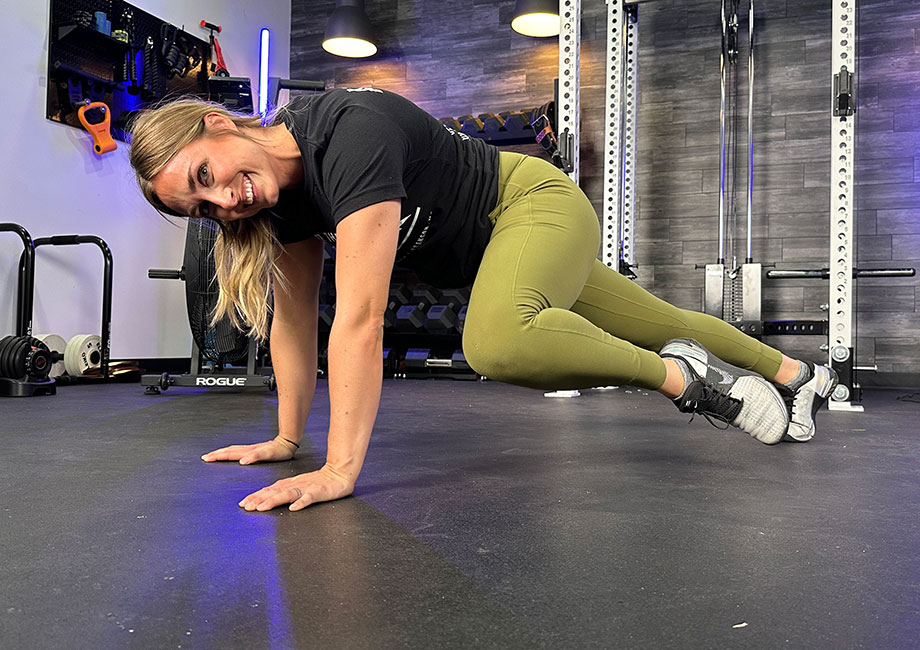We test and review fitness products based on an independent, multi-point methodology. If you use our links to purchase something, we may earn a commission. Read our disclosures.
Mountain climbers are more than just a great warm-up movement.
They’re a bodyweight exercise that can help enhance cardio, improve core strength, increase agility, and totally torch calories while providing muscle activation throughout your entire body. Plus, they are simple to learn, making them accessible to folks of all fitness levels, and can be performed virtually anywhere, as long as you have some space available.
RELATED: At-Home Bodyweight Workout
Kate Meier, NASM-CPT, USAW-L1, CF-L1, and GGR head of content, breaks down this beginner-friendly movement, providing step-by-step instructions, top trainer tips, common mistakes to avoid, and variations to take your mountain climbers to new heights!
How to Do Mountain Climbers
- Get into a high plank position with your hands shoulder-width apart. Your body should form a straight line from head to toe with your back flat, core engaged, and neck neutral.
- Bring your right knee into your chest towards your right elbow.
- Switch legs quickly, bringing your right leg back to the starting position as you pull your left leg forward instead, bringing your left knee towards your left elbow.
- Continue alternating sides until you complete the desired number of reps.
- Alternately, you can add a twist to your mountain climber by bringing your working knee to the opposite elbow.
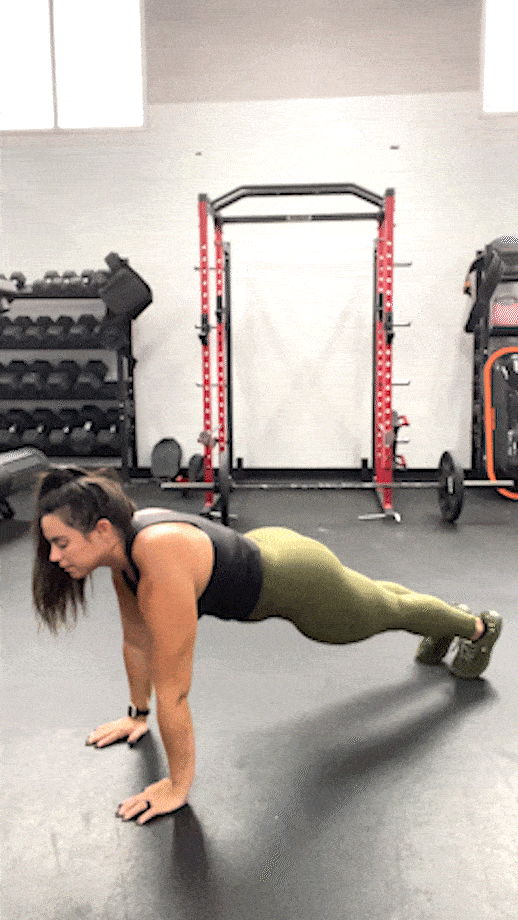
Trainer Tips for Form
Seems simple enough, right? Not so fast. Here are Kate Meier’s (CPT, USAW-L1, CF-L1) top tips to help ensure you’re doing mountain climbers the correct way and getting a great cardio and core workout in the process!
RELATED: Ultimate 10-Minute Ab Workout
Take It Slow At First
Flying through your mountain climbers is a surefire way to get the heart rate up, but it may not be your best bet for reaping the most benefit from this bodyweight exercise.
“Moving quickly provides an intense cardio stimulus, but it comes at a cost,” says Kate. “If you’re bouncing off your toes each rep, you may not be engaging your upper body and core muscles to the same degree as you would by moving slowly.”
So, if you’re trying to get the most bang for your buck from each repetition, try performing the mountain climber exercise slowly and with control, moving fluidly through the range of motion and contracting each muscle group as you go.
Think Knee to Elbow
Pulling your knees straight into your chest causes a contraction of the rectus abdominis, the abdominal muscle responsible for that classic “six-pack” appearance in individuals with low body fat, but that’s going to be mostly the full extent of core activation.
“Bringing your knees to your elbows instead of straight into your chest increases core activation by recruiting the external and internal obliques on the sides of your body,” says Kate. “That extra core activation helps promote greater overall core strength and stability.”
And that enhanced core strength and stability is invaluable, both in exercise and in everyday life. Studies show1 that core training, using some of the best ab exercises like mountain climbers, crunches, and the classic isometric plank, “may improve static balance, core endurance, and running economy,” while a strong core is also known to “protect the spine from excessive force, …[and] play an important role in body stabilization.”
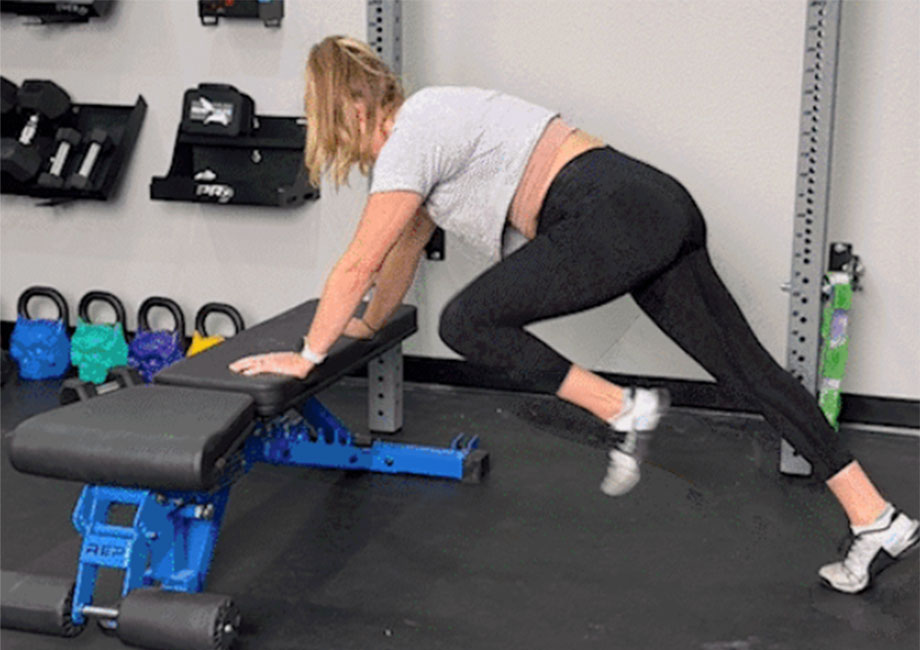
According to the Journal of Functional Morphology and Kinesiology2, core training is also shown to help reduce pain and improve non-specific low back pain.
So, whether you’re an athlete looking to up your game or an average person just looking to get through your day relatively pain-free, increased core strength through functional core exercises is worth it.
Tuck Your Belly Button
Speaking of maximizing the core activation during the mountain climber exercise, tucking your belly button into your spine is another crucial aspect of proper form that helps engage the deepest core muscles, namely the transverse abdominis and multifidus.
“Many people aren’t quite sure how to do this,” says Kate. “Start by taking a deep breath, then pull the belly inward and upward as though you’re trying to squeeze into a tight pair of jeans.”
From there, hold the abdominal contraction, resume breathing normally, and begin your set of mountain climbers. It’s a confusing cue, but taking the time to learn how to do this will ultimately optimize your core engagement and help you build more core stability over time.
Common Mountain Climber Mistakes
It’s not easy to remember every last cue when you’re in the middle of an HIIT workout, so here are the most common mountain climber mistakes to focus on to maintain good form.
RELATED: Benefits of HIIT
Hips Sinking
The perfect push-up and the high plank position involve creating a straight line that extends from your head and shoulders through the lower body and down to your feet. That’s exactly what you want to achieve with your body positioning during mountain climbers, too.
Many people inadvertently let their hips sag as they become increasingly fatigued. We get it. Mountain climbers are a high-intensity cardio workout that totally takes it out of you, but it’s important that you hold that positioning, keeping your hips perfectly aligned, no matter what.
RELATED: Plank Exercises
If you’re struggling, consider reducing your number of reps to ensure you’re able to maintain proper form throughout the full set. It’s always better to do a smaller number of perfect reps instead of a mix of some perfect reps and some sloppy reps toward the end.
Retracted Shoulder Blades
You’re going to work your lower body muscles, including the glutes, quads, and hamstrings, a whole bunch during your set of mountain climbers, but holding your body steady requires great upper body strength and shoulder stability.
The best way to maximize shoulder stability during mountain climbers is by protracting your shoulder blades or rounding them forward.
“Shoulder tightness and weakness can make it hard to properly protract the scapulae, so people wind up retracting them instead since it’s common positioning for many other exercises,” says Kate. “If you’re struggling to round your shoulders forward while doing mountain climbers, consider working in some shoulder strength training or mobility exercises to help.”
Bouncing Off of Your Toes
Bouncing off your toes turns this low-impact exercise into an almost-plyometric rendition that’s guaranteed to get your heart pumping and thumping before long, but that’s not going to give you your best chance at getting a strong muscle contraction in the many target muscle groups.
“It’s not always feasible to take things slow if your mountain climbers are part of a WOD or HIIT workout,” says Kate, “But if you’re doing them as a finisher exercise after a strength training session or full-body workout, you’ll get more benefits and better muscle activation going slow.”
Mountain Climber Variations
Mountain climbers are a full-body exercise that require no equipment whatsoever. These mountain climber variations are also accessible, making them an intuitive addition to your workout routine.
Knee to Chest
Why do it: Bringing your knees to your elbows is a great way to rope in the obliques, as well as opening up the hip flexors for some improvements to your hip mobility, but you can alter the movement pattern by simply bringing your knees directly toward your chest.
Doing so activates the rectus abdominis with more intensity, allowing you to really cycle your reps rapidly, which will be crucial if you find high-repetition sets of mountain climbers in your CrossFit WOD or other HIIT workout.
RELATED: CrossFit Workouts At Home
How to do it: To perform, simply do mountain climbers per usual (see above), but keep your knees inside your elbows and bring them toward your chest instead. You’re really going to feel this one!
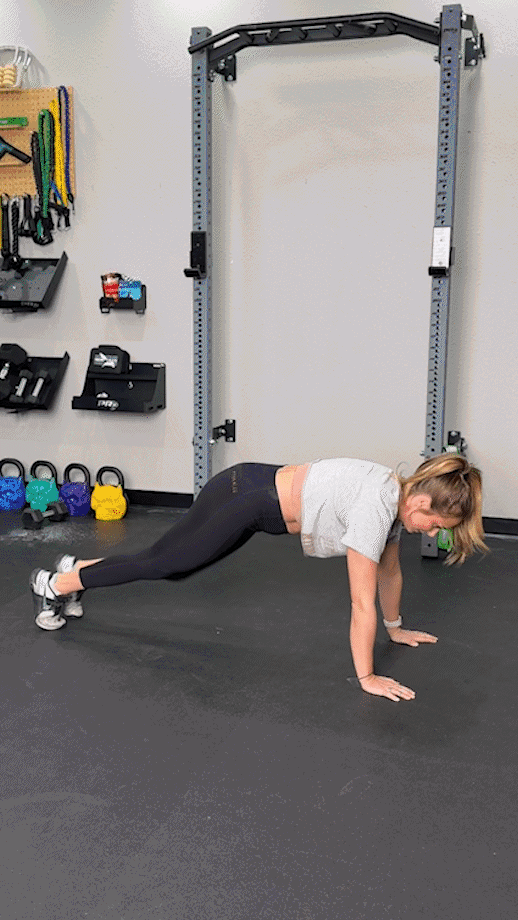
Incline Mountain Climbers
Why do it: Performing mountain climbers from the high plank position is generally doable for most, but some individuals with shoulder issues looking to alleviate the load placed on the shoulder joint (or those with limited space) might consider converting their standard mountain climbers into incline mountain climbers.
How to do it: Simply grab a flat weight bench or other sturdy object to rest your palms on and get going with some knee-to-chest mountain climber reps. While the incline may offer some relief to your shoulder joints, you’re still going to get one heck of a workout throughout your entire body, including your upper body muscles like the shoulders, triceps, and core muscles.
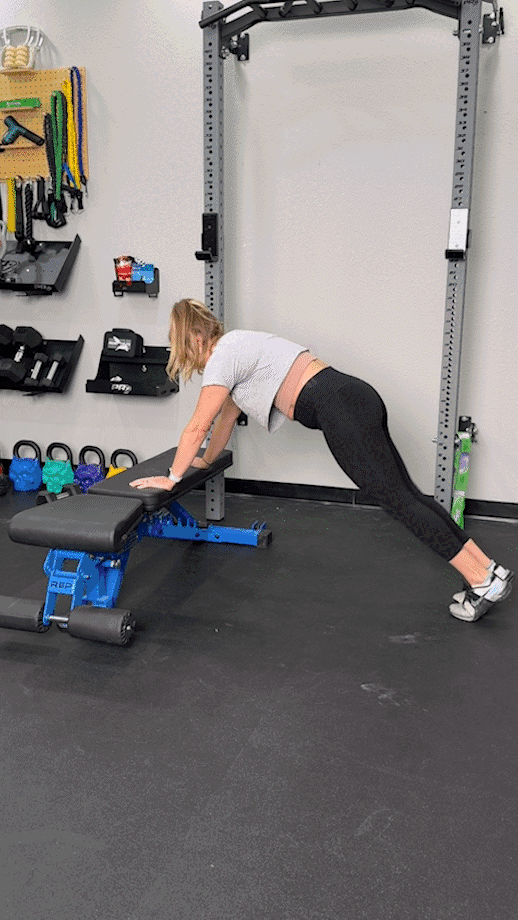
Sliding Mountain Climbers
Why do it: The mountain climber exercise is already a low-impact, joint-friendly movement, but placing your feet on a set of exercise sliders—like the SKLZ Court Slidez Exercise Sliders—turns it into a legit non-impact exercise. As in none, nada, zero, zilch; and nothing is joint-friendlier than that! You’d think that’d make things more manageable, but the major muscle groups of your body will still scream after blasting through a high-rep set of these bad boys.
How to do it: To perform sliding mountain climbers, simply place your feet on the sliders and start repping away as you would during the standard mountain climber (see above), keeping your feet touching the sliders at all times.
No sliders? No problem! A dry gym towel works in a pinch as long as you’re doing mountain climbers on a smooth floor. Just toss down two small towels, place your feet on top, and voilà—instant sliders!
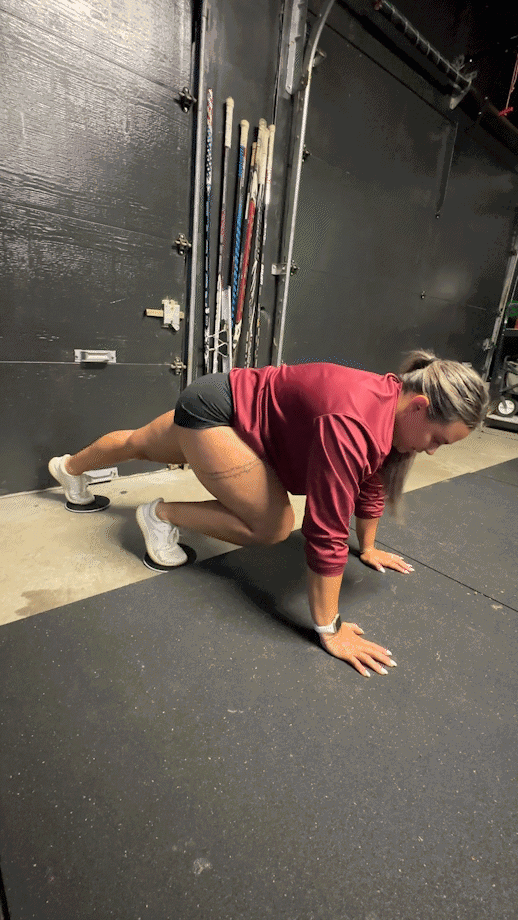
Useful Mountain Climber Equipment and Accessories
Do you need anything to do mountain climbers? Technically, no. But can a few useful accessories make the exercise more comfortable? You betcha!
Yoga Mat or Exercise Mat
Whether you’re a budget-conscious home gym owner, avid yogi, or occasional apartment exerciser, having a great exercise mat at your disposal will provide seemingly endless value while costing comparatively very little.
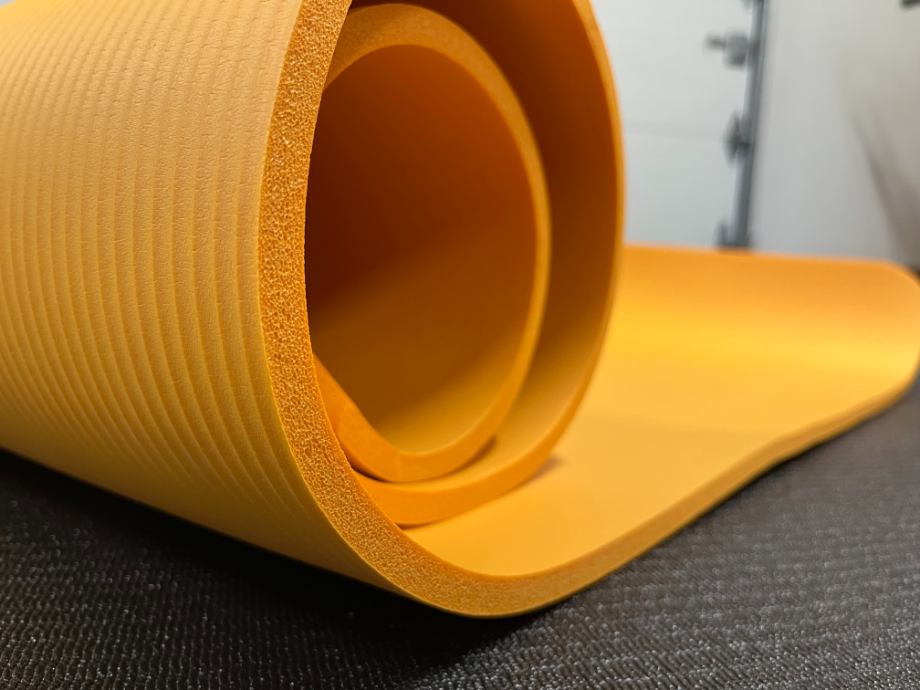
Do yourself a favor and invest in one of the best exercise mats today for mountain climbers, ab exercises, and other floor work that will call for a nice, cushy mat.
Yoga Towel
Nothing beats that feeling you get when you’re completely in the zone. So, the last thing you want is to ruin that feeling with something silly and avoidable, like sweaty hands.
Sweat is a given if you’re really attacking your workout, but sweaty palms make it hard to keep a stable base during your mountain climber reps, meaning your risk of slipping, sliding, and falling on your face is much higher. Ouch!
A high-quality yoga towel is an inexpensive solution, and its usefulness doesn’t end there. Your yoga towel will also be there for tough treadmill workouts, hot yoga sessions, and much more!
Mountain Climbers: FAQs
What are mountain climbers good for?
There are many benefits of mountain climbers, including:
– Providing muscle activation throughout entire body
– Enhancing cardiorespiratory fitness3
– Increasing core stability
– Improving coordination, strength, and endurance4
– Burning calories to encourage weight maintenance
– Requiring no equipment to perform
What will 100 mountain climbers a day do?
“Calisthenics exercises, including mountain climbers, burpees, and jumping jacks, are effective for improving muscle size, strength, and endurance, cardiovascular fitness and health, and burning calories to promote a healthy weight,” says Kate Meier, CPT, USAW-L1, CF-L1, and GGR head of content.
Performing 100 mountain climbers each day will probably contribute towards these goals, but there are plenty of other exercises that might also help speed things along and prevent you from burning yourself out.
For personalized fitness advice to best meet your goals, consider working with a certified personal trainer, coach, or other qualified fitness professional.
RELATED: Best Online Personal Trainer
Do mountain climbers burn belly fat?
Mountain climbers provide muscle activation throughout the body and get the heart rate up there, but they don’t specifically target belly fat.
Instead, mountain climbers burn fat everywhere, so you should see some of that stubborn belly fat start to disappear while also watching it vanish in other areas of the body, as long as you’re consistent with your workout routine and support your success with proper nutrition, hydration, and muscle recovery.
RELATED: Best Muscle Recovery Tools
References
1. Hung KC, Chung HW, Yu CC, Lai HC, Sun FH. Effects of 8-week core training on core endurance and running economy. PLoS One. 2019;14(3):e0213158. Published 2019 Mar 8. doi:10.1371/journal.pone.0213158
2. Frizziero A, Pellizzon G, Vittadini F, Bigliardi D, Costantino C. Efficacy of Core Stability in Non-Specific Chronic Low Back Pain. J Funct Morphol Kinesiol. 2021;6(2):37. Published 2021 Apr 22. doi:10.3390/jfmk6020037
3. Archila LR, Bostad W, Joyner MJ, Gibala MJ. Simple Bodyweight Training Improves Cardiorespiratory Fitness with Minimal Time Commitment: A Contemporary Application of the 5BX Approach. Int J Exerc Sci. 2021;14(3):93-100. Published 2021 Apr 1.
4. Dransmann M, Koddebusch M, Gröben B, Wicker P. Functional High-Intensity Interval Training Lowers Body Mass and Improves Coordination, Strength, Muscular Endurance, and Aerobic Endurance of Inmates in a German Prison. Front Physiol. 2021;12:733774. Published 2021 Sep 30. doi:10.3389/fphys.2021.733774
Further reading

Rowing machine workouts are a great way to improve your fitness. Here are four rowing workouts to try next time you hop on your erg. Read more

Looking for strategies for how to squat heavier? We’ve got tips from an Olympian in this article. Read more

Challenge your glutes, hamstrings, and posterior chain next leg day with our expert-tested top picks for the best Nordic bench. Read more

American Barbell is by and large making some of the best training equipment available, and the Urethane Pro Series Bumper Plates are no exception. Utilizing urethane instead of the traditional rubber creates an ultra-durable, low bounce plate, with vibrant colors. These are the best competition bumper plates we've had the opportunity to review to date. Read more

